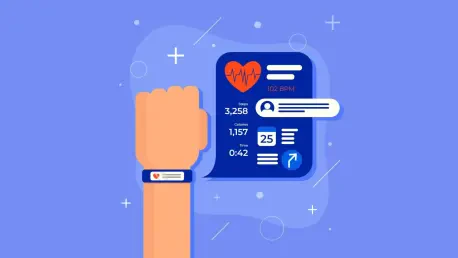In an era where health consciousness is at an all-time high, the emergence of budget-friendly wearable devices powered by artificial intelligence has sparked a revolution in personal wellness management. Imagine a world where cutting-edge technology, once reserved for the elite with deep pockets, is now accessible to anyone with a modest budget, empowering individuals to monitor vital health metrics like heart rate, sleep quality, and stress levels with unprecedented precision. These affordable AI wearables are not just gadgets; they represent a seismic shift in how everyday people approach fitness and well-being. Gone are the days when advanced health tracking was synonymous with exorbitant costs. Today, sophisticated sensors and intelligent algorithms are bundled into devices that cater to the masses, delivering personalized insights through companion apps. This democratization of technology raises compelling questions about accessibility and the future of health monitoring, setting the stage for a deeper exploration of their transformative impact.
Breaking Down Barriers with Budget-Friendly Tech
The most striking aspect of affordable AI wearables lies in their ability to bridge the gap between high-end functionality and cost-effective design. These devices, often priced at a fraction of premium smartwatches, integrate accurate sensors to track a wide array of health metrics, from daily step counts to intricate sleep patterns. What sets them apart is the use of AI, primarily through companion apps, which analyze raw data and provide actionable insights tailored to individual needs. This means users can receive personalized recommendations for improving workout recovery or managing stress without shelling out hundreds of dollars. Brands have cleverly shifted the heavy lifting of AI processing to apps rather than embedding complex hardware in the devices themselves, ensuring costs remain low while maintaining effectiveness. This strategic approach has opened doors for a broader audience, allowing students, retirees, and budget-conscious consumers to access tools that were once out of reach, fundamentally changing the landscape of personal health technology.
Another dimension of this accessibility is the diversity of options available in the budget category, each offering unique strengths without compromising on quality. Devices like the Amazfit Band Series, paired with the Zepp app, excel in delivering detailed sleep and workout analysis, while the Fitbit Inspire 3 provides AI-driven Daily Readiness Scores to guide users on activity levels. Similarly, the Xiaomi Smart Band offers robust activity tracking via the Mi Fitness app, and the Huawei Band 8 stands out with its TruSleep AI for in-depth sleep monitoring. These wearables prove that affordability does not equate to subpar performance; instead, they bring sophisticated health insights to the fingertips of users who might otherwise forgo such technology. Comfort, long battery life, and compatibility with both iOS and Android systems further enhance their appeal, ensuring they fit seamlessly into daily life. This variety underscores a key trend: advanced health tracking is no longer an exclusive privilege but a widely attainable resource for proactive wellness.
Redefining Health Insights Through Intelligent Analysis
The true power of affordable AI wearables emerges in their capacity to transform raw data into meaningful, personalized health guidance. Unlike earlier fitness trackers that merely recorded steps or calories burned, these modern devices leverage AI algorithms to interpret complex metrics such as heart rate variability, stress levels, and recovery times. Through companion apps, users receive tailored suggestions, like adjusting sleep schedules or incorporating mindfulness exercises to lower stress, based on real-time data analysis. This shift from passive tracking to active coaching marks a significant evolution in wearable technology, empowering individuals to make informed decisions about their health. The emphasis on app-based AI ensures that even budget devices can offer insights comparable to those of high-end models, proving that sophisticated wellness tools are not bound by price tags. Such advancements highlight how technology can serve as a personal health advisor, accessible to anyone willing to strap on a wearable.
Beyond the individual benefits, the rise of these wearables reflects a broader cultural shift toward preventive health care, driven by accessible technology. As more people adopt these devices, a collective focus on wellness emerges, with users encouraged to prioritize self-care through data-driven feedback. The practical advice embedded in companion apps, such as reminders to stay active or tips for better sleep hygiene, fosters consistent engagement with health goals. For instance, regular syncing of data and adherence to app recommendations can amplify the effectiveness of these wearables, turning them into indispensable tools for long-term well-being. This trend also signals a growing trust in AI to deliver reliable health insights, as users see tangible improvements in their fitness and stress management. The impact extends beyond personal use, potentially influencing public health initiatives by providing aggregated data on population wellness trends, all made possible by the widespread adoption of affordable, intelligent wearables.
Pioneering a New Era of Wellness Accessibility
Reflecting on the journey of affordable AI wearables, it’s evident that their integration into daily life marked a turning point in health technology over recent years. These devices dismantled financial barriers, offering sophisticated monitoring and analysis that rivaled premium options, ensuring that wellness became a priority for a wider demographic. Looking ahead, the focus should shift to maximizing their potential through consistent usage and engagement with companion app features. Users are encouraged to explore the full range of insights these wearables provide, from sleep optimization to stress reduction strategies, to truly harness their benefits. Additionally, manufacturers might consider enhancing app functionalities or integrating more community-driven features to foster shared learning and motivation. As this technology continues to evolve, staying informed about emerging devices and updates will be crucial for anyone invested in personal health. This ongoing revolution in accessible wellness tech promises to keep pushing boundaries, making proactive health management an achievable goal for all.









